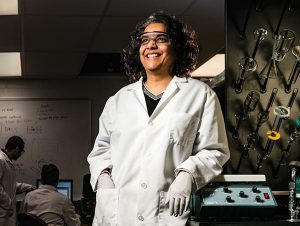
Polymeric biomaterials combined with nanoscale delivery devices can improve preventative medicine
Surya Mallapragada knows the value an engineering perspective can add to advancing the biomedical field.
For years, Mallapragada, the Carol Vohs Johnson Chair in Chemical and Biological Engineering, has been researching the best ways to synthesize copolymers and nanoscale delivery devices to treat illnesses. Now, she’s looking at ways to prevent disease.
“When we were focused on treatment technologies, we wanted to minimize the immune response to the drugs that were being delivered to a patient, creating an environment that would allow the medicine to be effective in fighting against a disease,” she explains.
Shifting her focus to preventative medicine like vaccines, Mallapragada says her team wants to maximize immune responses to different drugs so the patient is protected against a variety of diseases and stays healthy. “We have a good understanding of which chemistries will elicit the right response given the different applications,” she adds.
That information is being put to use within nanoscale drug-delivery devices Mallapragada’s team is designing. Her group is focusing on vaccines that carry just the proteins or DNA from pathogens, a change from traditional vaccines that have been created using live, or attenuated, pathogens.
“When we use attenuated pathogens, we have to consider a number of factors, including growing a virus somewhere like chicken eggs and transporting and storing the virus,” she says. “Since our work is using only part of a pathogen in a nanoscale delivery device made of a polymer, we can design materials that are more robust without having to worry about the disadvantages of working with live viruses.”
Mallapragada’s work is part of the polymers and materials research going on within the Nanovaccine Initiative at Iowa State. The initiative includes several researchers who are developing nanoparticle platforms that can be used in disease prevention.
“The platform technologies we are creating aren’t necessarily disease specific. It’s a bigger picture plan to improve both the effectiveness and accessibility of vaccines,” Mallapragada adds. One example would be having a team look at using proteins or pieces of pathogens to create a combination vaccine that fights both influenza and pneumonia since those diseases can often occur together.
The projects involve interdisciplinary teams that include researchers and medical professionals both on and off campus. “Immunologists are learning about materials science, and students and post docs in engineering are learning about cell cultures and animal models,” Mallapragada says. “The collaborative environment has allowed us to thrive, and we’re looking forward to seeing these projects eventually head to human clinical trials.”